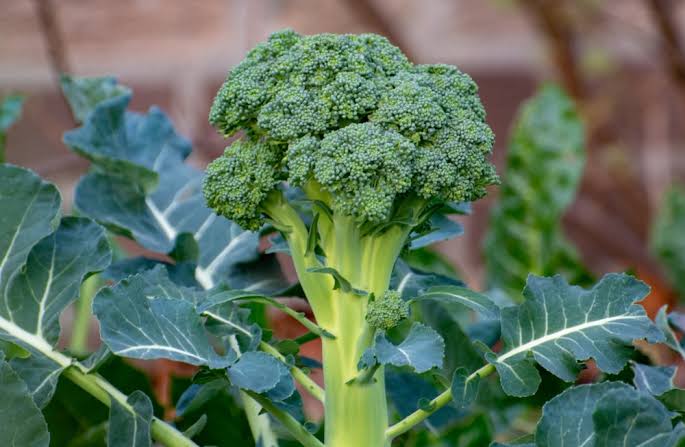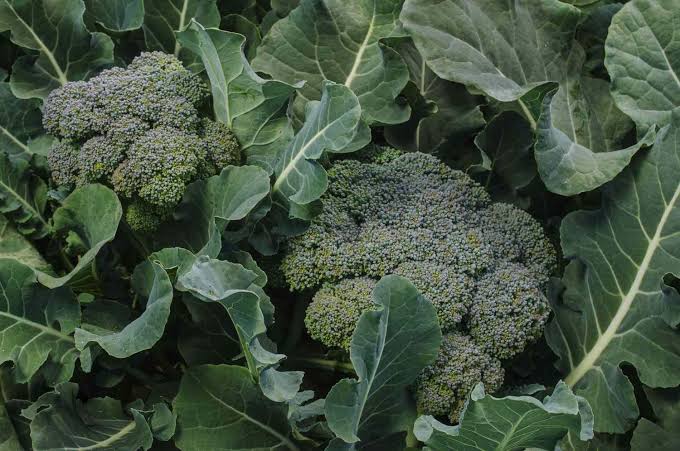Broccoli is a green vegetable that grows in gardens, it is part of the cabbage family. Broccoli has a lot of small green clusters on top. People eat these clusters, which are also called florets. When you look at broccoli, you might notice it looks like a little tree.
This vegetable is full of vitamins and minerals that are good for our bodies. It has vitamin C, which helps keep us healthy. Eating broccoli is like giving our bodies a boost of goodness. It also has fiber, which is important for our digestion. Fiber helps things move smoothly in our tummies.
When you cook broccoli, it changes from being crunchy to being soft. Some people like to steam it, while others might prefer to boil or even roast it. You can make it different ways to suit your taste.
One special thing about broccoli is that it comes in different colors. Most broccoli is green, but you might also find some that is purple or even yellow. It’s like a colorful surprise in the vegetable world.
Broccoli is a good friend to our health. It helps us grow strong and keeps us feeling good. So, the next time you see a plate with broccoli, remember that it’s not just a green vegetable – it’s a little powerhouse of goodness!
Broccoli is not only good for our health but also for the environment. When farmers grow broccoli, they take care of the soil and use fewer chemicals. This means that choosing broccoli can be a good choice for our planet too.
Now, let’s talk about the taste of broccoli. Some people might think it’s a bit earthy or even a little bitter, but that’s what makes it interesting. When you cook it just right, broccoli becomes deliciously tender and takes on the flavors of the seasonings you use.
One fun thing about broccoli is that you can pair it with different foods. Some people like to add cheese to their broccoli, creating a creamy and savory dish. Others might mix it with pasta or stir-fry it with colorful veggies, making a tasty and wholesome meal.
Parents often encourage their children to eat broccoli because it helps them grow big and strong. It’s like nature’s way of providing a tiny green powerhouse that supports our bodies in many ways.
Broccoli is not just a side dish; it can be the star of the meal. From salads to soups, broccoli finds its way into various recipes, adding a burst of nutrition and flavor.
In addition, broccoli is more than just a vegetable – it’s a versatile, nutritious, and eco-friendly addition to our plates. So, the next time you see those green clusters, remember you’re not just eating a vegetable; you’re savoring a piece of nature’s goodness that benefits both you and the world around you.
Read Also: Tamarillos: History, Nutrition, Health Benefits and Growing Guide
How to Grow Broccoli

Growing broccoli can be a rewarding experience, and here’s a simple guide to help you cultivate this nutritious vegetable:
1. Choose the Right Time: Broccoli prefers cool weather. Plant it in early spring or late summer for the best results.
2. Pick a Suitable Location: Select a spot with full sunlight. Broccoli needs at least 6 hours of sunlight daily to thrive.
3. Prepare the Soil: Broccoli prefers well-draining soil rich in organic matter. Work compost into the soil before planting to provide essential nutrients.
4. Planting: Sow broccoli seeds or transplant seedlings into the prepared soil. Space the plants about 18-24 inches apart to give them enough room to grow.
5. Watering: Keep the soil consistently moist but not waterlogged. Broccoli plants require regular watering, especially during dry spells.
6. Fertilizing: Feed the plants with a balanced fertilizer when they are about 3-4 weeks old. Follow the instructions on the fertilizer package for the correct application.
7. Mulching: Mulch around the broccoli plants to retain moisture, suppress weeds, and regulate soil temperature.
8. Pest Control: Keep an eye out for common pests like cabbage worms. Consider using natural pest control methods or insecticidal soap to protect your broccoli.
9. Harvesting: Harvest broccoli when the heads are firm and tight, before the buds start to open. Cut the main head with a sharp knife, leaving the plant in place to produce side shoots.
10. Storage: Store harvested broccoli in the refrigerator. It can stay fresh for up to a week if kept in a plastic bag or wrapped in a damp cloth.
Growing broccoli may take some care, but the delicious and nutritious reward is worth the effort. Whether you’re a seasoned gardener or a beginner, cultivating your own broccoli can be a satisfying and healthful experience.
Read Also: Ugli Fruit: History, Nutrition, Health Benefits and Growing Guide
The Health Benefits of Broccoli

Broccoli offers a range of health benefits, making it a valuable addition to a balanced diet:
1. Nutrient-Rich: Broccoli is packed with essential nutrients, including vitamin C, vitamin K, vitamin A, and folate. These vitamins play vital roles in supporting overall health, from immune function to bone health.
2. Antioxidant Power: It contains antioxidants like sulforaphane, which may help protect cells from damage caused by free radicals. Antioxidants contribute to reducing the risk of chronic diseases.
3. Heart Health: The fiber, potassium, and antioxidants in broccoli contribute to heart health. The fiber helps lower cholesterol levels, while potassium helps regulate blood pressure.
4. Digestive Health: Broccoli is a good source of dietary fiber, aiding in digestion and promoting a healthy gut. Fiber also helps prevent constipation and supports a balanced digestive system.
5. Cancer Prevention: Compounds in broccoli, such as sulforaphane, have been studied for their potential anti-cancer properties. They may help reduce the risk of certain cancers by supporting the body’s natural defense mechanisms.
6. Bone Health: Broccoli is rich in vitamin K and calcium, essential for maintaining strong and healthy bones. Consuming an adequate amount of vitamin K is crucial for bone mineralization.
7. Weight Management: With its low calorie content and high fiber content, broccoli can be a great addition to a weight-conscious diet. The fiber helps with satiety, making you feel fuller for longer.
8. Blood Sugar Regulation: The fiber and antioxidants in broccoli may contribute to better blood sugar control, benefiting individuals with diabetes or those aiming to prevent insulin resistance.
9. Skin Health: The combination of vitamin C and other antioxidants in broccoli can support skin health by promoting collagen production and protecting against damage from the sun and environmental factors.
10. Eye Health: Broccoli contains compounds like lutein and zeaxanthin, which are associated with a lower risk of age-related macular degeneration and support overall eye health.
Incorporating broccoli into your diet as part of a varied and balanced eating plan can contribute to overall well-being and support numerous aspects of your health.
How to Care for Broccoli

Caring for broccoli involves providing the right conditions for its growth and protecting it from common issues. Here’s a guide on how to care for broccoli:
1. Sunlight: Plant broccoli in a location that receives full sunlight. Broccoli thrives with at least 6 hours of direct sunlight each day.
2. Soil Preparation: Ensure well-draining soil enriched with organic matter. Work compost into the soil before planting to provide essential nutrients.
3. Watering: Keep the soil consistently moist, especially during dry periods. Water the base of the plants to avoid wetting the foliage, which can lead to diseases.
4. Mulching: Apply a layer of mulch around the base of the plants to retain moisture, suppress weeds, and regulate soil temperature. Mulching also helps prevent soil splash onto the leaves, reducing the risk of certain diseases.
5. Fertilization: Use a balanced fertilizer when the broccoli plants are 3-4 weeks old. Follow the recommended application rates on the fertilizer package.
6. Pest Control: Monitor for common pests like cabbage worms, aphids, and caterpillars. Consider using natural methods like introducing beneficial insects or applying insecticidal soap if necessary.
7. Disease Management: Keep an eye out for signs of diseases such as downy mildew or black rot. Proper spacing, good air circulation, and avoiding overhead watering can help prevent diseases.
8. Pruning: Remove yellowing or damaged leaves regularly to encourage the plant’s energy to focus on producing healthy florets.
9. Harvesting: Harvest the main broccoli head when it is firm and compact, cutting it about 6 inches below the head. Allow the plant to continue producing smaller side shoots for extended harvest.
10. Crop Rotation: Practice crop rotation to prevent the buildup of pests and diseases in the soil. Avoid planting broccoli in the same spot every year.
11. Support: If your broccoli plants become top-heavy or are exposed to windy conditions, consider providing support to prevent them from bending or breaking.
Read Also: Waste to Energy Business: What You Need to Know

